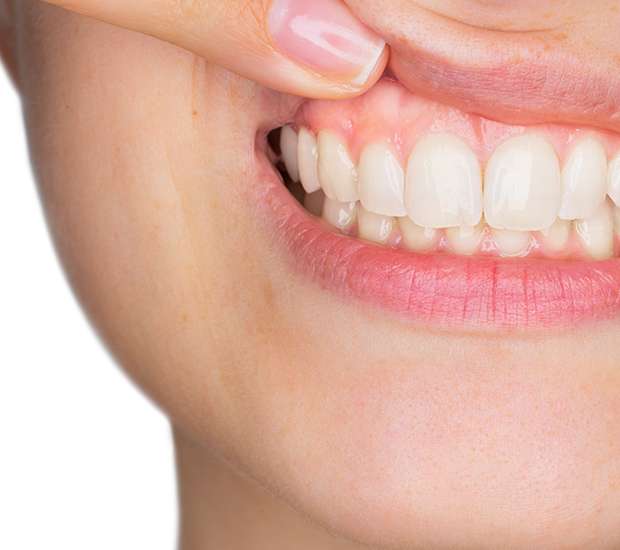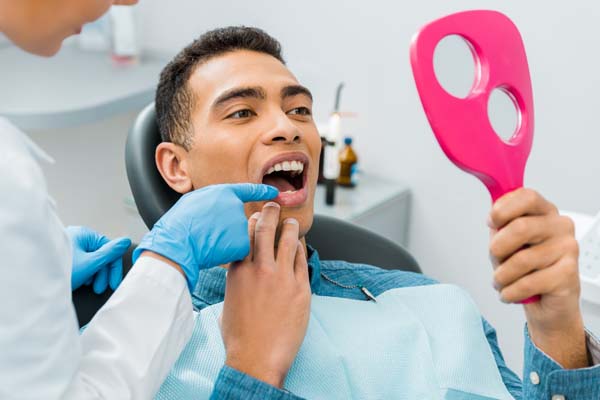Periodontal DiseaseVirginia Beach, VA
Periodontal disease, also known as gum disease or periodontitis, is a problem that many people do not think needs professional treatment. In fact, many people are content to wait and follow the belief that regular brushing is all someone needs to keep the teeth healthy. While regular brushing and flossing are important, periodontal disease can cause a variety of problems in patients who do not seek professional treatment early on.
In fact, the Centers for Disease Control and Prevention, CDC, found that close to 65 million people in the U.S. display signs of gum disease. Even though not everyone enjoys dental care, it is crucial to seek professional treatment as early as possible to prevent the disease from spreading. We can offer the professional treatment to do so.
Prevent Health Issues with Dental Implants
While there can be a small amount of bleeding in the gums when a patient brushes of flosses for the first time following a period of poor oral hygiene. However, the bleeding gums should not continue after a few days. The intensity of brushing or flossing can also be a cause of bleeding gums, in some cases. Even if vigorous brushing is the cause of the bleeding, it is important to see a professional in order to identify the cause and prevent any further damage.
Signs and symptoms of periodontal disease include:
These are only a few of the symptoms that can appear in the teeth. People may not realize that periodontitis is the advanced stage of gum disease. While gum disease is treatable without surgery in the early stages, it is not as easily treatable in the later stages. With periodontitis, the gums and bone will pull away from the teeth.
This will create pockets of empty space that can trap plaque and food particles. Over time, these will infect the area and can begin to spread to the other teeth. This is how the teeth can begin to come loose and eventually fall out. The sooner people seek treatment, the better.
Treatment Options
The most common cause of periodontal disease is poor oral hygiene habits over a prolonged period of time. These include:
While these are only a few of the potential causes, oral hygiene is crucial for one’s health. The infection can spread from the teeth to other areas of the body. Once this happens, the patient will be in a much worst situation than before. Fortunately, we have several treatment options available to help treat periodontal disease, including:
Dental Deep Cleaning
A dental deep cleaning is also known as root scaling/cleaning and is much more than a simple dental cleaning. A deep clean procedure involves removing the plaque and calculus on the teeth. Calculus, known as tartar, is a hardened dental plaque that needs professional tools for removal. We will use these tools to break up the plaque and calculus on the teeth and in the gaps between the teeth and gums.
By removing the pieces of plaque and smoothing out the gums, we can help to close the pockets so this does not continue to happen. This process may take one or two appointments depending on the amount of plaque and calculus. Since periodontal disease will continue to occur, it is important to keep up proper oral hygiene after this treatment.
Bone Grafting
One of the more evasive options, bone grafting is a surgical procedure that involves replacing the bone tissue that the periodontal disease destroyed. Through guided tissue regeneration, we can help to direct the growth of new bone in specific areas. We can also use bone from another area of the patient’s body or from a donor.
The patient will be asleep during this procedure as we help to add the bone to the afflicted areas of the jaw. While we will do everything we can to preserve as much of the natural bone structure as possible, it may be necessary to remove any infected portions.
Soft Tissue Grafts
A soft tissue graft works in the same idea as a bone graft. By taking a tissue sample from the mouth or another donor, we can use it to replace the damaged tissue. Once we remove the damaged tissue, we will be able to place the new gum tissue in the specific area. If the tissue sustains too much damage from the periodontal disease, then we will need to use this procedure or another to treat the patient.
We will normally begin this after we remove the periodontal disease and treat the patient. Thus, there is less chance for the infection to reoccur. Call us to learn more about available treatment options and schedule an appointment.




